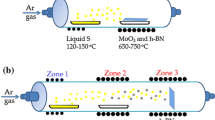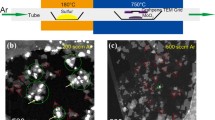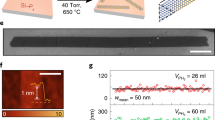Abstract
Chemical vapor deposition has proven to be one of the most promising approaches to achieve large-scale and high-quality ultra-thin layered materials in general, and single- and few-layer transition metal dichalcogenides in particular. Therefore, the study of the conditions affecting the growth and the obtained structure (morphology and chemical composition) is of crucial importance in order to improve its consistency and generalize these methodologies for the growth of other 2D materials. Here, we show that the growth temperature and pressure have significant effect on the final MoS2 morphology, leading to completely different results: homogeneous surface coverage with inorganic fullerenes, loosely surface bound thin elongated hexagonal nanostructures and single-layer domains. This work focuses on the characterization of the less common elongated hexagonal nanostructures, including their growth mechanism, phase, chemical composition, doping and electronic properties. An interesting epitaxial relation between the MoS2 layers and the metal oxide particle, which may have practical implications in the future, is demonstrated and discussed as well. Finally, we demonstrate the in situ doping and alloying to form MoS2-xSex nanostructures. This work provides new insights into the growth mechanism puzzle of MoS2 nanostructures.







Similar content being viewed by others
References
Novoselov KS et al (2012) A roadmap for graphene. Nature 490(7419):192–200
Bonaccorso F et al (2012) Production and processing of graphene and 2d crystals. Mater Today 15(12):564–589
Li X et al (2009) Large-area synthesis of high-quality and uniform graphene films on copper foils. Science 324(5932):1312–1314
Butler SZ et al (2013) Progress, challenges, and opportunities in two-dimensional materials beyond graphene. ACS Nano 7(4):2898–2926
Bhimanapati GR et al (2015) Recent advances in two-dimensional materials beyond graphene. ACS Nano 9(12):11509–11539
Guo W et al (2018) Controlling fundamental fluctuations for reproducible growth of large single-crystal graphene. ACS Nano 12(2):1778–1784
Hao Y et al (2013) The role of surface oxygen in the growth of large single-crystal graphene on copper. Science 342(6159):720–723
Ismach A et al (2010) Direct chemical vapor deposition of graphene on dielectric surfaces. Nano Lett 10(5):1542–1548
Lin L et al (2016) Surface engineering of copper foils for growing centimeter-sized single-crystalline graphene. ACS Nano 10(2):2922–2929
Yan Z et al (2012) Toward the synthesis of wafer-scale single-crystal graphene on copper foils. ACS Nano 6(10):9110–9117
Ismach A et al (2012) Toward the controlled synthesis of hexagonal boron nitride films. ACS Nano 6(7):6378–6385
Ismach A et al (2017) Carbon-assisted chemical vapor deposition of hexagonal boron nitride. 2D Mater 4:025117
Mende PC et al (2017) Characterization of hexagonal boron nitride layers on nickel surfaces by low-energy electron microscopy. Surf Sci 659:31–42
Shi YM et al (2010) Synthesis of few-layer hexagonal boron nitride thin film by chemical vapor deposition. Nano Lett 10(10):4134–4139
Song L et al (2010) Large scale growth and characterization of atomic hexagonal boron nitride layers. Nano Lett 10(8):3209–3215
Kim KK et al (2012) Synthesis of monolayer hexagonal boron nitride on Cu foil using chemical vapor deposition. Nano Lett 12(1):161–166
Tay RY et al (2014) Growth of large single-crystalline two-dimensional boron nitride hexagons on electropolished copper. Nano Lett 14(2):839–846
Lu GY et al (2015) Synthesis of large single-crystal hexagonal boron nitride grains on Cu-Ni alloy. Nat Commun 6:6160
Jang AR et al (2016) Wafer-scale and wrinkle-free epitaxial growth of single-orientated multilayer hexagonal boron nitride on sapphire. Nano Lett 16(5):3360–3366
Fiori G et al (2014) Electronics based on two-dimensional materials. Nat Nanotechnol 9(10):768–779
Xia FN et al (2014) Two-dimensional material nanophotonics. Nat Photonics 8(12):899–907
Hod O et al (2018) Flatlands in the holy land: the evolution of layered materials research in Israel. Adv Mater 30:1706581
Liu Y et al (2014) Mesoscale imperfections in MoS2 atomic layers grown by a vapor transport technique. Nano Lett 14(8):4682–4686
Lee Y-H et al (2012) Synthesis of large-area MOS2 atomic layers with chemical vapor deposition. Adv Mater 24(17):2320–2325
Kang K et al (2015) High-mobility three-atom-thick semiconducting films with wafer-scale homogeneity. Nature 520(7549):656–660
Gao Y et al (2015) Large-area synthesis of high-quality and uniform monolayer WS2 on reusable Au foils. Nat Commun 6:8569
Yu H et al (2017) Wafer-scale growth and transfer of highly-oriented monolayer MoS2 continuous films. ACS Nano 11(12):12001–12007
Bilgin I et al (2015) Chemical vapor deposition synthesized atomically thin molybdenum disulfide with optoelectronic-grade crystalline quality. ACS Nano 9(9):8822–8832
Liu X et al (2016) Rotationally commensurate growth of MoS2 on epitaxial graphene. ACS Nano 10(1):1067–1075
Yu Y et al (2013) Controlled scalable synthesis of uniform, high-quality monolayer and few-layer MoS2 films. Sci Rep 3:1866
Eichfeld SM et al (2015) Highly scalable, atomically thin WSe2 grown via metal-organic chemical vapor deposition. ACS Nano 9(2):2080–2087
Kim H et al (2017) Suppressing nucleation in metal-organic chemical vapor deposition of MoS2 monolayers by Alkali Metal Halides. Nano Lett 17(8):5056–5063
Lin Y-C et al (2018) Realizing large-scale, electronic-grade two-dimensional semiconductors. Acs. NANO 12(2):965–975
Wang S et al (2014) Shape evolution of monolayer MoS2 crystals grown by chemical vapor deposition. Chem Mater 26(22):6371–6379
Diaz HC et al (2016) High density of (pseudo) periodic twin-grain boundaries in molecular beam epitaxy-grown van der Waals heterostructure: MoTe2/MoS2. Appl Phys Lett 108(19):191606
Ehlen N et al (2019) Narrow photoluminescence and Raman peaks of epitaxial MoS2 on graphene/Ir(111). 2d Mater 6(1):011006
Lin HC et al (2018) Growth of atomically thick transition metal sulfide films on graphene/6H-SIC(0001) by molecular beam epitaxy. Nano Res 11(9):4722–4727
Poh SM et al (2018) Molecular beam epitaxy of highly crystalline MoSe2 on hexagonal boron nitride. ACS Nano 12(8):7562–7570
Xenogiannopoulou E et al (2015) High-quality, large-area MoSe2 and MoSe2/Bi2Se3 heterostructures on AlN(0001)/Si(111) substrates by molecular beam epitaxy. Nanoscale 7(17):7896–7905
Chiappe D et al (2016) Controlled sulfurization process for the synthesis of large area MoS2 films and MoS2/WS2 heterostructures. Adv Mater Interfaces 3(4):1500635
Orofeo CM et al (2014) Scalable synthesis of layer-controlled WS2 and MoS2 sheets by sulfurization of thin metal films. Appl Phys Lett 105(8):083112
Feng Q et al (2014) Growth of large-area 2D MoS2(l-x,)Se2x, Semiconductor. Adv Mater 26(17):2648–2653
Cai Z et al (2018) Chemical Vapor Deposition Growth and Applications of Two-Dimensional Materials and Their Heterostructures. Chem Rev 118:6091–6133
Zhu DC et al (2017) Capture the growth kinetics of CVD growth of two-dimensional MoS2. Npj 2D Mater Appl 1:1–8
Shang SL et al (2016) Lateral Versus Vertical Growth of Two-Dimensional Layered Transition-Metal Dichalcogenides: Thermodynamic Insight into MoS2. Nano Lett 16(9):5742–5750
Ye H et al (2017) Toward a mechanistic understanding of vertical growth of van der Waals Stacked 2D materials: a multiscale model and experiments. ACS Nano 11(12):12780–12788
Yun SJ et al (2015) Synthesis of centimeter-scale monolayer tungsten disulfide film on gold foils. ACS Nano 9(5):5510–5519
Shi JP et al (2015) Substrate facet effect on the growth of mono layer MoS2 on Au foils. ACS Nano 9(4):4017–4025
Rajan AG et al (2016) Generalized mechanistic model for the chemical vapor deposition of 2D transition metal dichalcogenide monolayers. ACS Nano 10(4):4330–4344
Cain JD et al (2016) Growth mechanism of transition metal dichalcogenide monolayers: the role of self-seeding fullerene nuclei. ACS Nano 10(5):5440–5445
Feldman Y et al (1996) Bulk synthesis of inorganic fullerene-like MS(2) (M = Mo, W) from the respective trioxides and the reaction mechanism. J Am Chem Soc 118(23):5362–5367
Wu K et al (2018) Controllable defects implantation in MoS2 grown by chemical vapor deposition for photoluminescence enhancement. Nano Res 11(8):4123–4132
Zak A et al (2009) Insight Into the growth mechanism of WS2 nanotubes in the scaled-up fluidized-bed reactor. NANO 4(2):91–98
Duan X et al (2014) Lateral epitaxial growth of two-dimensional layered semiconductor heterojunctions. Nat Nanotechnol 9(12):1024–1030
Dhakal KP et al (2017) Local strain induced band gap modulation and photoluminescence enhancement of multilayer transition metal dichalcogenides. Chem Mater 29(12):5124–5133
Conley HJ et al (2013) Bandgap engineering of strained monolayer and bilayer MoS2. Nano Lett 13(8):3626–3630
Tenne R (2006) Inorganic nanotubes and fullerene-like nanoparticles. Nat Nanotechnol 1(2):103–111
Tenne R, Seifert G (2009) Recent progress in the study of inorganic nanotubes and fullerene-like structures. Ann Rev Mater Res 39:387–413
DeGregorio ZP, Yoo Y, Johns JE (2017) Aligned MoO2/MoS2 and MoO2/MoTe2 freestanding core/shell nanoplates driven by surface interactions. J Phys Chem Lett 8(7):1631–1636
Wu D et al (2018) Epitaxial growth of highly oriented metallic MoO2@MoS2 nanorods on C-sapphire. J Phys Chem C 122(3):1860–1866
Park T et al (2017) Synthesis of vertical MoO2/MoS2 core-shell structures on an amorphous substrate via chemical vapor deposition. J Phys Chem C 121(49):27693–27699
Dieterle M, Mestl G (2002) Raman spectroscopy of molybdenum oxides—Part II. Resonance Raman spectroscopic characterization of the molybdenum oxides Mo4O11 and MoO2. Phys Chem Chem Phys 4(5):822–826
Mak KF et al (2010) Atomically thin MoS2: a new direct-gap semiconductor. Phys Rev Lett 105(13):136805
Tongay S, et al (2013) Defects activated photoluminescence in two-dimensional semiconductors: interplay between bound, charged, and free excitons. Sci Rep 3:2657
Nan H et al (2014) Strong photoluminescence enhancement of MoS2 through defect engineering and oxygen bonding. ACS Nano 8(6):5738–5745
Desai SB et al (2014) Strain-induced indirect to direct bandgap transition in multilayer WSe2. Nano Lett 14(8):4592–4597
Gulbransen EA, Andrew KF, Brassart FA (1963) Vapor pressure of molybdenum trioxide. J Electrochem Soc 110(3):242–243
Zhu D et al (2017) Capture the growth kinetics of CVD growth of two-dimensional MoS2. npj 2D Mater Appl 1(1):8
Dumcenco D et al (2015) Large-area epitaxial mono layer MoS2. ACS Nano 9(4):4611–4620
Ruzmetov D et al (2016) Vertical 2D/3D Semiconductor Heterostructures Based on Epitaxial Molybdenum Disulfide and Gallium Nitride. ACS Nano 10(3):3580–3588
Bana H et al (2018) Epitaxial growth of single-orientation high-quality MoS2 monolayers. 2D Mater 5(3):035012
Yan A et al (2015) Direct growth of single- and few-layer MoS2 on h-BN with preferred relative rotation angles. Nano Lett 15(10):6324–6331
Dahl-Petersen C et al (2018) Topotactic growth of edge-terminated MoS2 from MoO2 nanocrystals. ACS Nano 12:5351–5358
Rogers DB et al (1969) Crystal chemistry of metal dioxides with rutile-related structures. Inorg Chem 8(4):841–849
Le CT et al (2017) Impact of Selenium Doping on Resonant Second-Harmonic Generation in Monolayer MoS2. Acs Photonics 4(1):38–44
Feng QL et al (2015) Growth of MoS2(1-x)Se2x (x = 0.41-1.00) Monolayer alloys with controlled morphology by physical vapor deposition. Acs Nano 9(7):7450–7455
Song JG et al (2015) Controllable synthesis of molybdenum tungsten disulfide alloy for vertically composition-controlled multilayer. Nat Commun 6:7817
Duan XD et al (2016) Synthesis of WS2xSe2-2x Alloy Nanosheets with Composition-Tunable Electronic Properties. Nano Lett 16(1):264–269
Wang ZQ et al (2018) Synthesizing 1T-1H Two-Phase Mo1-xWxS2 Monolayers by Chemical Vapor Deposition. ACS Nano 12(2):1571–1579
Wi S et al (2014) Enhancement of photovoltaic response in multilayer MoS2 induced by plasma doping. ACS Nano 8(5):5270–5281
Sun QC et al (2013) Observation of a Burstein-Moss shift in rhenium-doped MoS2 nanoparticles. ACS Nano 7(4):3506–3511
Fang H et al (2013) Degenerate n-Doping of Few-Layer Transition Metal Dichalcogenides by Potassium. Nano Lett 13(5):1991–1995
Acknowledgements
G.R., T.S. and A.I. acknowledge the support from the Israel Science Foundation, Grant Number 1784/15, and the Israeli Ministry of Energy, research Grant Number 0605405442.
Author information
Authors and Affiliations
Corresponding author
Ethics declarations
Conflict of interest
This manuscript has not been published and is not under consideration for publication elsewhere. We have no conflicts of interest to disclose.
Additional information
Publisher's Note
Springer Nature remains neutral with regard to jurisdictional claims in published maps and institutional affiliations.
Electronic supplementary material
Below is the link to the electronic supplementary material.
Rights and permissions
About this article
Cite this article
Radovsky, G., Shalev, T. & Ismach, A. Tuning the morphology and chemical composition of MoS2 nanostructures. J Mater Sci 54, 7768–7779 (2019). https://doi.org/10.1007/s10853-019-03437-4
Received:
Accepted:
Published:
Issue Date:
DOI: https://doi.org/10.1007/s10853-019-03437-4




